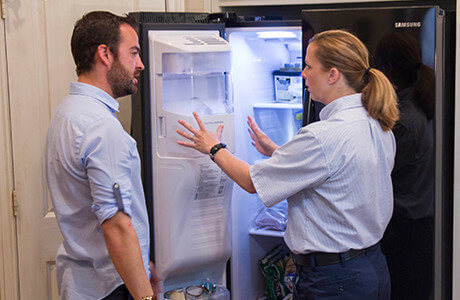The Ultimate Overview to Commercial Refrigeration Fixing: Necessary Steps and Typical Problems Described

Common Industrial Refrigeration Issues
When operating commercial refrigeration devices, services may encounter a number of usual problems that can impact the performance and functionality of the devices. One common issue is inappropriate temperature level policy. Rising and fall temperature levels within the refrigeration unit can bring about food wasting, enhanced energy usage, and endangered quality and security standards. This problem often stems from a defective thermostat, incorrect door seals, or poor insulation.
Another typical problem is refrigerant leakages. Leakages can arise from wear and tear, inadequate installment, or making issues. Reduced refrigerant levels not only hinder the device's cooling ability yet can also result in compressor failure if left unaddressed.
In addition, ice build-up on evaporator coils is a constant concern. Ice build-up restricts airflow, triggering the device to function more challenging and take in even more energy. Normal cleansing and upkeep of the coils can aid prevent this issue.
Crucial Devices for Repairing Refrigeration Units
Making use of the proper tools is critical for efficiently repairing industrial refrigeration devices to guarantee ideal performance and long life. Among the fundamental tools needed are manifold assesses for examining refrigerant stress, refrigeration wrenches for tightening or loosening up fittings, a multimeter for testing electrical elements, and leak detection tools such as digital leak detectors or ultraviolet dye sets.
In the realm of specialized tools, tube cutters and flaring tools are important for working with copper tubing, while a recuperation maker is required for securely getting rid of cooling agents. A temperature gun can be helpful for rapidly identifying temperature level differentials within the unit. Buying high-grade devices not only enhances performance during repairs yet additionally adds to the accuracy and integrity of the maintenance job executed on business refrigeration devices.
Step-by-Step Troubleshooting Overview

The next step is to test the temperature level controls and setups to guarantee they are functioning correctly. This includes inspecting the thermostat, defrost timer, and other control devices to confirm that they are regulating the temperature level as meant. If any type of discrepancies are discovered, substitutes or adjustments might be check it out needed. commercial refrigeration repair.
Consequently, the technician ought to examine the condenser and evaporator coils for dust or debris buildup, which can hinder correct air conditioning. Cleaning these elements can typically deal with problems with temperature level policy and performance.

Preventative Maintenance Methods
Carrying out routine preventative maintenance procedures is necessary for guaranteeing the longevity and optimal efficiency of industrial refrigeration systems. By adhering to an aggressive upkeep schedule, businesses can lessen the risk of costly failures, stop downtime, and extend the life expectancy of their refrigeration equipment.
One critical preventative upkeep strategy is routine cleaning of condenser coils. With time, these coils can build up dust, dust, and debris, which can restrain heat transfer and decrease the system's effectiveness. By cleansing the coils regularly, organizations can guarantee that the refrigeration system runs at peak performance.
In addition, checking and replacing worn gaskets on doors is an additional vital maintenance job. Damaged gaskets check it out can result in air leaks, triggering the refrigeration system to function more difficult to maintain the desired temperature. By changing defective gaskets promptly, companies can boost energy effectiveness and extend the life of the tools.
Incorporating these preventative maintenance techniques into a thorough maintenance plan can aid companies enhance the efficiency and integrity of their commercial refrigeration systems.
Professional Repair Service Vs. DO IT YOURSELF: Cons and pros
Engaging an expert repair work solution for business refrigeration systems offers distinctive benefits over trying do it yourself fixings. Industrial refrigeration systems are complicated systems that require specialized knowledge and abilities to detect and fix properly. Experts have the training and experience to recognize concerns properly, bring about quicker and extra exact repair services. They likewise have accessibility to sophisticated tools and equipment that might not be conveniently offered to the average individual.
Moreover, specialist fixing services typically give service warranties on their job, giving you satisfaction understanding that the job is guaranteed. Trying to repair a business refrigeration system on your own can bring about additional damages if not done correctly, possibly leading to even more costly repairs down the line. In addition, DIY repair work might nullify any kind of existing guarantees on the equipment, leaving you only in charge of any future concerns that may arise. While DIY repairs might seem affordable originally, the lasting advantages of professional repair service services surpass the uncertainties and dangers related to attempting repair services on your own.
Conclusion
In final thought, recognizing common commercial refrigeration problems, having the crucial devices for fixing, following a detailed troubleshooting overview, and implementing preventative maintenance methods are crucial parts of keeping and repairing industrial refrigeration systems. While expert repair service solutions might supply competence and performance, do it yourself fixings can additionally be an affordable choice for those with the required skills and understanding. Eventually, routine maintenance and timely repair services are essential for guaranteeing the correct performance of industrial refrigeration systems.
Comprehending the crucial steps for industrial refrigeration fixing and being able to recognize typical problems are important skills for any kind of company owner or upkeep employees. In this detailed overview, we will discover the basic steps and typical problems in industrial refrigeration repair, furnishing you with the knowledge required to attend to these difficulties effectively.
Engaging a professional fixing service for industrial refrigeration systems offers distinctive advantages over attempting Do it yourself repair work. Trying to repair a business refrigeration system yourself can lead to further damages if not done appropriately, potentially resulting in even more costly fixings down the line.In final thought, understanding common business refrigeration issues, having the essential devices for you can find out more repair, complying with a step-by-step troubleshooting overview, and implementing preventative upkeep techniques are vital components of keeping and repairing commercial refrigeration units.